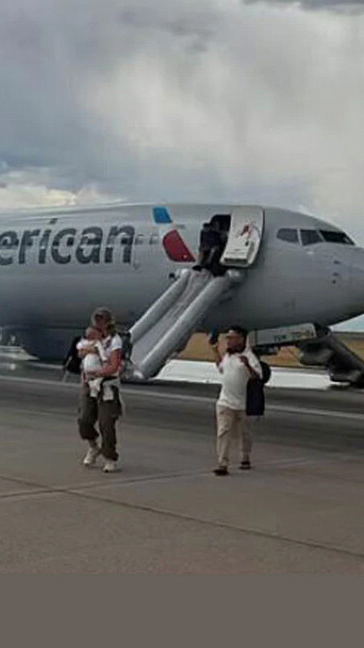A routine takeoff turned into a runway emergency Saturday evening when an American Airlines Boeing 737 Max bound for Miami erupted in flames at Denver International Airport, forcing a full-scale evacuation.
The aircraft, carrying 179 people, suffered a landing gear malfunction that triggered a brake fire, according to the Federal Aviation Administration (FAA). Flames were reported shortly after the plane began its taxi for takeoff, prompting immediate action from the flight crew and emergency responders. One passenger was hospitalized with minor injuries. Five others were treated at the scene, though none sustained life-threatening harm. Airport firefighters quickly contained the blaze, and the jet was pulled from service for a full inspection. A replacement aircraft eventually completed the flight.
But for the passengers, those minutes felt anything but routine.
“The plane started vibrating and shaking really bad,” Shay Armistead told CNN. Others reported hearing a loud bang followed by smoke seeping into the cabin. One traveler said she saw “flames coming out from under the plane.”
Panic quickly spread. Cell phone footage posted to social media platform X shows passengers fleeing down emergency slides while dark smoke pours from the undercarriage. Screams can be heard over the background of emergency alerts and crew commands.
This isn’t the first black mark on the Boeing 737 Max’s already controversial track record. The aircraft model has been under intense scrutiny since two fatal crashes in 2018 and 2019 grounded the fleet worldwide for nearly two years. The Boeing 737 Max has become a symbol of modern aviation failure—a jet designed for efficiency that instead delivered tragedy. The aircraft was grounded worldwide in 2019 after two catastrophic crashes- Lion Air Flight 610 in Indonesia and Ethiopian Airlines Flight 302—that killed 346 people in total. Investigations revealed that a flawed flight control system, known as MCAS (Maneuvering Characteristics Augmentation System), repeatedly forced the planes into uncontrollable dives, and Boeing had failed to properly inform airlines and pilots about the system’s behavior.
The company’s internal culture, prioritizing speed to market over safety, was blasted in congressional hearings, and Boeing's credibility took a nosedive along with its stock. Though the Max was recertified in late 2020 with software fixes and pilot training upgrades, its name still carries baggage —both figurative and, now, flaming literal—as even unrelated mechanical issues, like the Denver brake fire, reignite public distrust.
While this latest incident appears to be unrelated to the flight control issues that plagued the Max series previously, it raises fresh concerns about the aircraft’s overall reliability—and American Airlines’ fleet management practices.
As of now, the FAA has launched a formal investigation into the malfunction.
In the airline industry, emergencies like this are rare—but not rare enough for comfort. Especially when Boeing is back in the News. This is a company that used to be the pride of American Aviation but now it has become a company that silences whistleblowers and maybe worse.
With public trust in Boeing still on shaky ground and airlines racing to meet post-pandemic demand, this incident underscores the thin line between routine and disaster at 30,000 feet—or in this case, before even leaving the ground.
The aviation system worked—the crew responded fast, the fire was extinguished, and lives were spared.
But as passengers deplaned down an emergency slide instead of a jet bridge, one thing is clear: in 2025, “safe enough” is not good enough.


